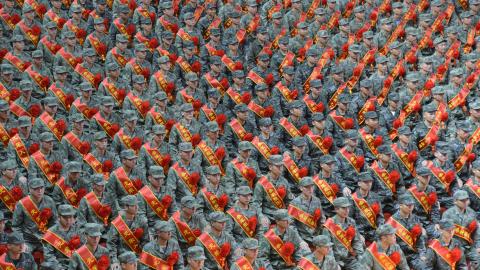For approximately 36 hours last month, the U.S. Air Force lost track of half a dozen nuclear weapons. Although Air Force leaders characterize the event as a unique occurrence, the incident will likely encourage opposition to the Bush administration's Prompt Global Strike plan, which aims give the United States the option of using nuclear and non-nuclear weapons on the same delivery systems.
On Aug. 30, the crew of an Air Force B-52H Stratofortress unknowingly carried six nuclear-tipped AGM-129 cruise missiles while flying from Minot Air Force Base in North Dakota to Barksdale Air Force Base in Louisiana. Throughout the three-and-a-half-hour flight, neither the plane's crew nor their air traffic controllers were aware that the aircraft was carrying nuclear munitions. The error was only discovered some nine hours after the plane had landed.
The immediate source of the problem was that, the previous morning, the ground crew had accidentally loaded six nuclear-armed AGM-129s onto a pylon that they then attached to the underside of one of the B-52's wings. The six missiles under the other wing were appropriately unarmed. From the 9 a.m. loading on Aug. 29 through the afternoon of Aug. 30, the six nuclear missiles remained under U.S. military custody, but without the special protection usually required of nuclear munitions.
The Air Force has decided to retire its remaining 400 AGM-129s, which are designed to carry a W80-1 nuclear warhead with a yield of 5 to 150 kilotons. The service will rely entirely on the more advanced Air-Launched Cruise Missiles. The unlucky crew of the Aug. 30 flight was transporting the AGM-129s to Barksdale for formal decommissioning, but the nuclear munitions should have been replaced with inert warheads at Minot prior to the trip.
In recent years, the Air Force typically has used only specially designated cargo planes (such as C-130 or C-17 aircraft) belonging to its Primary Nuclear Airlift Force (PNAF) to transport nuclear weapons by air. Such transfers occur most often between operational bases and other facilities when the weapons undergo maintenance, modernization, or (as in this case) retirement. Unlike patrolling bombers, cargo planes cannot launch nuclear strikes, so other countries are less likely to see their actions as threatening.
Air Force officials insist that the nuclear warheads never presented a danger to the crew or to the general public. They point out that the weapons had not been activated and have extensive safety features designed to prevent an accidental or deliberate explosion (i.e., one caused by terrorists). Nevertheless, the incident does raise concerns about the effectiveness of the Air Force's command and control safeguards for the handling of nuclear weapons.
The Department of Defense (DOD)—along with the Department of Energy, which designs and builds U.S. nuclear weapons—uses several computerized tracking programs to account for its nuclear warheads. DOD procedures also require explicit authorization by senior military commanders for any movement of U.S. nuclear weapons. According to those who have participated in the process, the Air Force protocols for the handling of nuclear munitions require multiple authorizations whenever a nuclear warhead is removed from its storage bunker, transported to a runway, or loaded onto a plane.
Since the AGM-129 does not have a conventionally armed variant, the Aug. 29-30 error involves more than a ground crew simply selecting the wrong version of the missile. An AGM-129 with a nuclear warhead also looks different (having special red markings) than one with an inert warhead.
The military considered the incident sufficiently serious to inform President Bush and Defense Secretary Robert Gates immediately. Gates initially requested daily briefings from the current Air Force Chief of Staff, Gen. Michael Moseley, on the status of the USAF inquiry led by Maj. Gen. Douglas Raaberg, director of air and space operations at Air Combat Command. More recently, Gates requested that former USAF chief of staff Larry Welch head a study by the Defense Science Board to determine the wider implications of the B-52 incident for the security and transfer of nuclear munitions.
The Air Force's investigation will likely focus on the behavior of the ground crew. Its members inexplicitly selected and loaded the six live nuclear warheads onto the plane, in apparent violation of numerous safety and security regulations. Pending the results of the inquiry, the Air Force has already relieved of his duties the munitions squadron commander who oversaw the Minot munitions crews. In addition, it has "temporarily decertified" other personnel from handling munitions. At a minimum, the Air Force will likely require that those involved undergo additional training.
Although an Air Force representative described the affair as an isolated mistake," the Air Combat Command ordered a stand down at all its bases—even those not involved with nuclear weapons—on Sept. 14. All Air Force commands suspended their normal "nonmission essential" operations to review proper munitions handling procedures.
The Air Force also subsequently conducted an unusually large number of no-notice and short-notice limited nuclear surety inspections of select Air Force units. The Air Force routinely performs these inspections to assess the safety, security and reliability of its nuclear weapons. The Aug. 30 incident, however, probably has resulted in reviews of whether USAF personnel are properly performing counting and verification procedures for stored nuclear munitions. The Air Combat Command, which operates the U.S. strategic bomber fleet, is inspecting its units. But so is the Air Force Space Command, which oversees the U.S. intercontinental ballistic missile (ICBM) arsenal.
The details of DOD nuclear security protocols are classified. The military also has a policy of not confirming information regarding the movement of U.S. nuclear weapons. During the Cold War, the secrecy was aimed primarily at discouraging public protests about the movement of nuclear explosive devices. Today, U.S. officials justify the policy by citing the need to prevent terrorists from seizing the weapons.
The Air Force's unauthorized transportation of nuclear munitions on Aug. 30 is certain to heighten concerns about the Bush administration's proposals to allow some U.S. ICBMs to carry conventional rather than nuclear warheads. Opponents of the Prompt Global Strike plan will now find it easier to argue that Russian, Chinese, and other governments cannot be sure whether any U.S. strategic missile is carrying a conventional warhead if American military units can mistakenly load nuclear weapons on U.S. delivery systems.

















